13 Feb Residential Supply Monitor
5 ways our monitor helps councils get a handle on their land and dwelling supply.
Amid Australia’s housing crisis, the need for accurate and reliable land and dwelling supply assessments has never been more critical. Traditional methods of evaluating land availability and occupancy have often relied on ad hoc consultancies that apply spot checks, outdated data, and inconsistently applied methodologies, obscuring the true land and dwelling supply available for development. Traditional methods are typically delivered as one-off projects, with the results quickly becoming outdated, and lacking the flexibility to repurpose for other projects.
Here are 5 ways our land supply monitor gives councils a better understanding of their residential land and dwelling supply, providing rich insights for decision-making.

1. Embracing modern assessment
Utilising automation, machine learning, advanced data analytics and geographic information systems (GIS), the team at REMPLAN have developed a transparent, repeatable, data-driven approach to reveal the pipeline of land and dwelling supply. REMPLAN’s Residential Supply Monitor is delivered through a software application with regular updates. This approach ensures the data and supply insights are always current, enabling application across multiple projects, and responses to ad-hoc enquiries.

2. Precision through analytics
The advantage of REMPLAN’s approach is its ability to enhance the accuracy, precision, reliability and currency of land and dwelling supply assessments using modern methods of analysis. Using high-resolution satellite imagery, in conjunction with cleansed publicly available data, REMPLAN is able to generate an up-to-date assessment of vacant and non-vacant land, to more accurately estimate the proportion of land can that can be reasonably developed.
Data-driven assessments provide a robust foundation for decision-making processes. REMPLAN’s Residential Supply Monitor allows councils to quickly run analyses as new data comes in, enabling planners and policymakers to make evidence based decisions regarding land allocation, zoning regulations, and infrastructure development. This approach reduces the risk of costly mistakes and ensures that land use decisions are based on the most current available data. While councils typically have an understanding of long term supply, traditional approaches often do not allow for accurate assessments of current and short-term supply.

3. Realistic Development Potential
REMPLAN’s yield model applies a sophisticated, multi-stage process to estimate realistic housing yields across different land use zones. Rather than relying on generic figures like minimum lot sizes or oversimplified assumptions, the model considers local characteristics, recent development patterns, and site-specific constraints.

4. Your Region, Your Way
The Residential Supply Monitor software allows users to adjust to the area they are assessing, enabling LGA-wide, suburb-specific and custom geography supply assessments. Users can understand exactly how much capacity is available in their focus area, helping to support and justify rezoning, development, and infrastructure investment decisions.

5. Stay Ahead of the Curve
Assess land supply against population forecasts, highlighting whether housing supply meets projected growth. By linking directly to REMPLAN’s population forecasts, the Residential Supply Monitor identifies neighbourhoods at risk of shortages. The tool supports customised forecast areas, moving beyond traditional boundaries like LGAs to visualise housing and land supply against demand. This flexibility ensures insights are tailored to specific project needs, guiding effective planning and development decisions.

Supply assessment as a service
Interested in moving from ad hoc assessments to a Residential Supply Monitor that is always up-to-date?
Contact us arrange a no obligation discussion of your requirements and how we can help you to assess your current and future residential supply.




No Comments